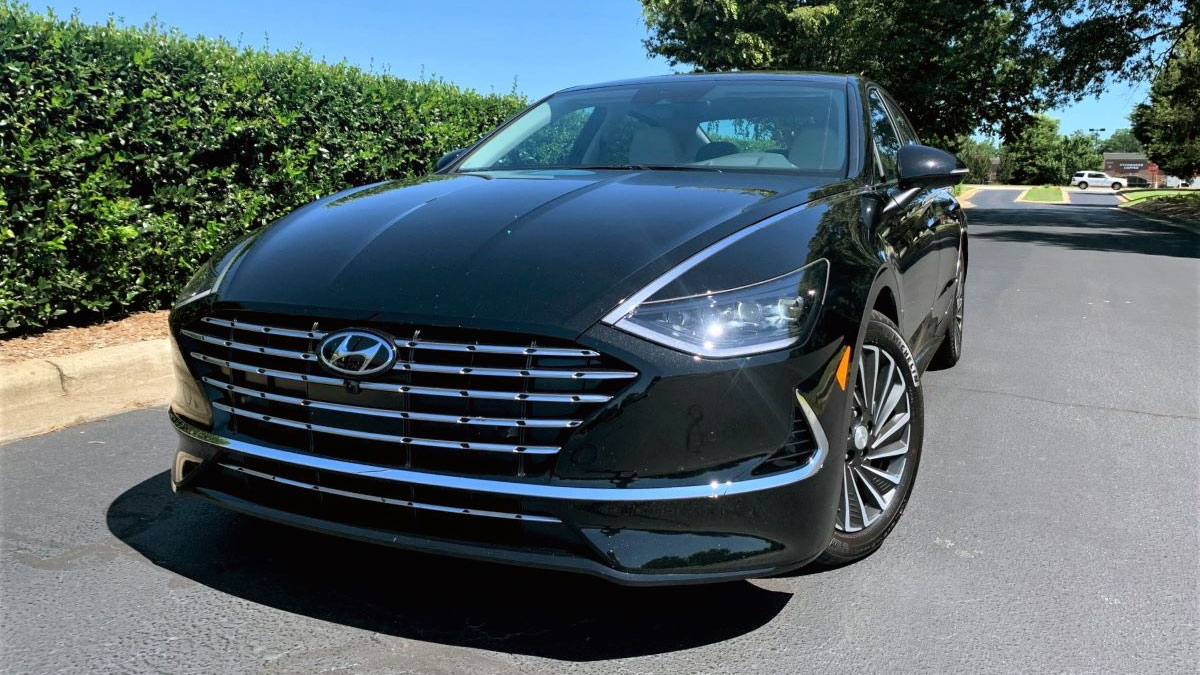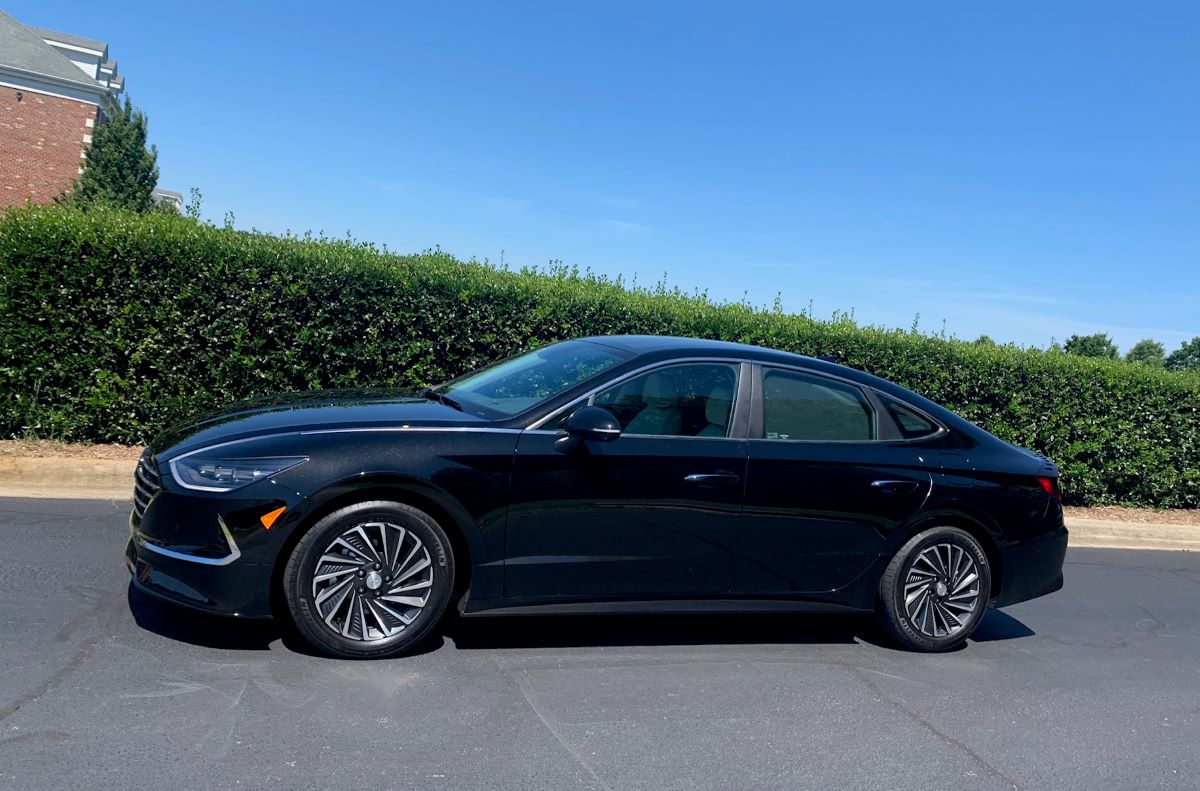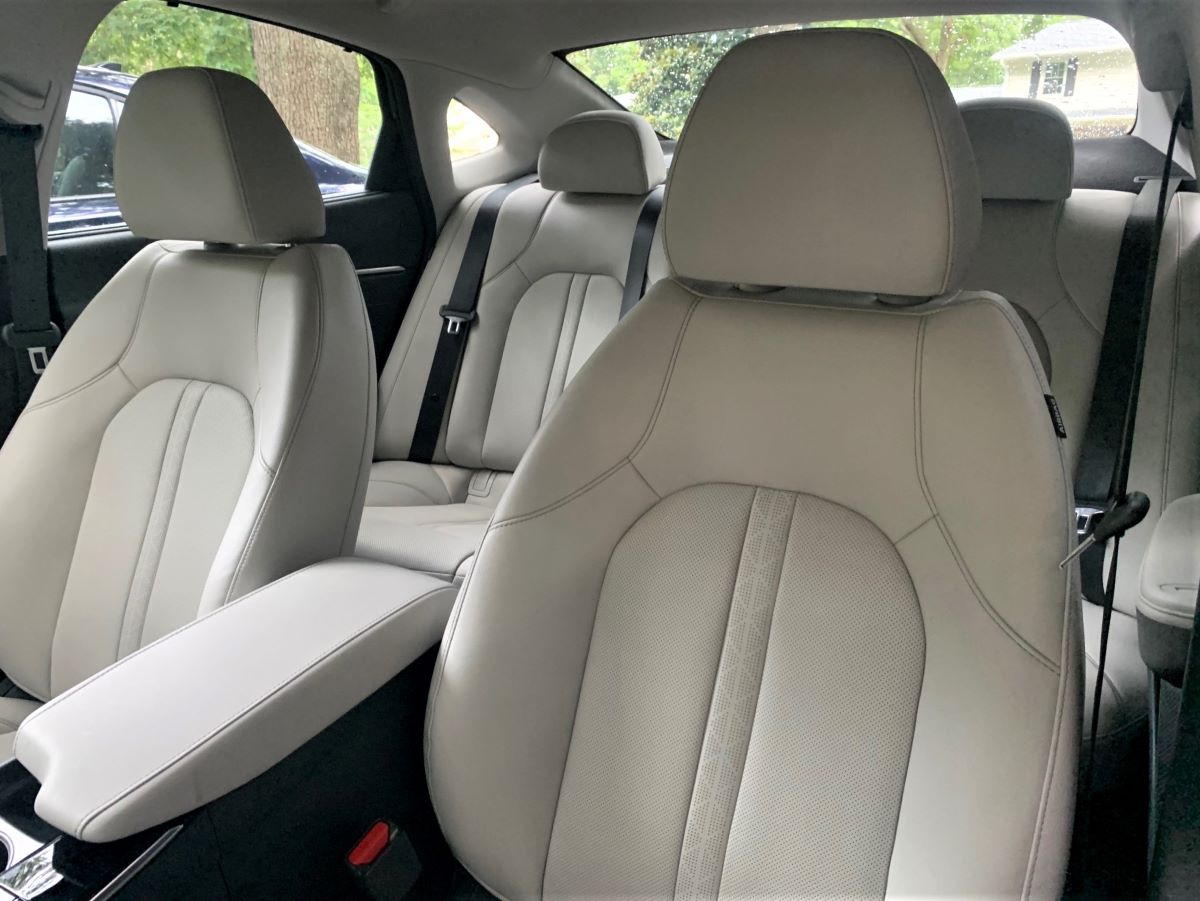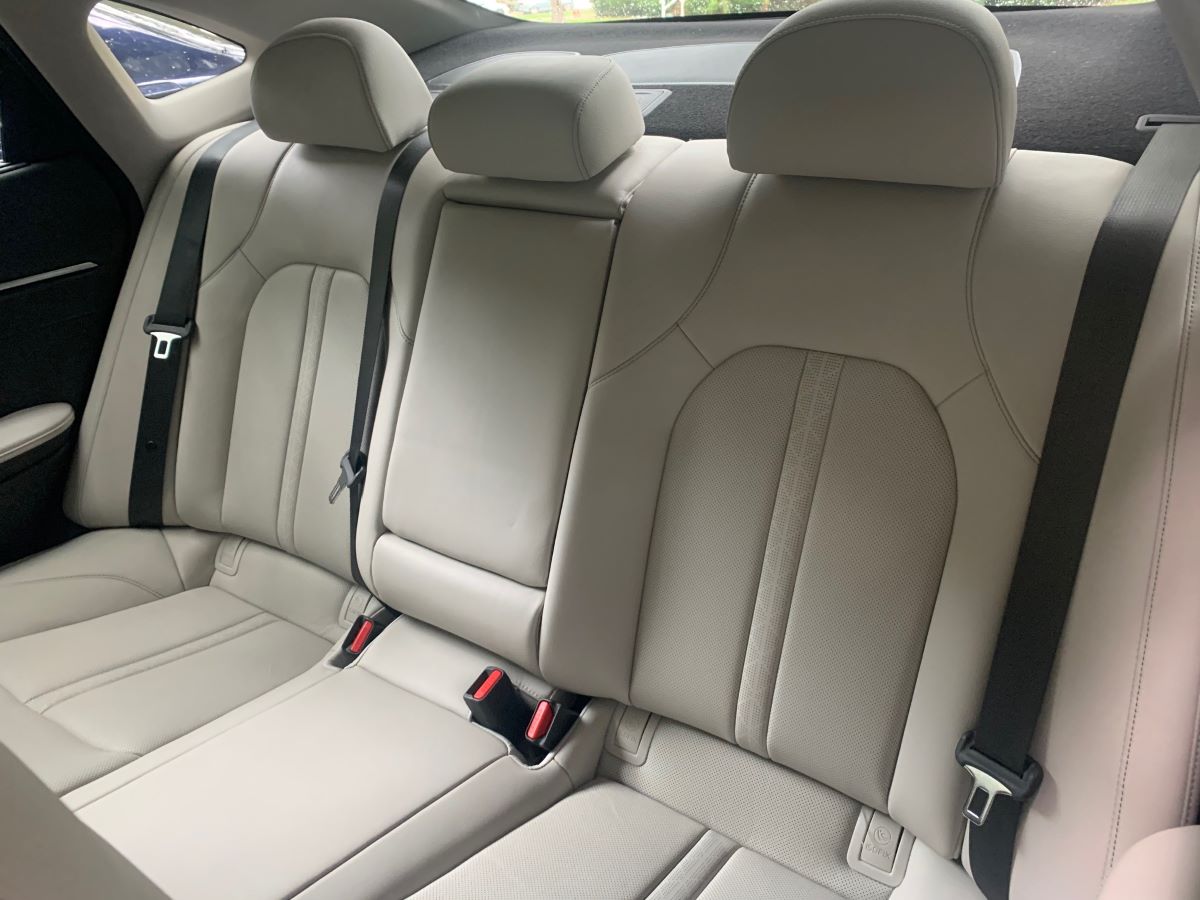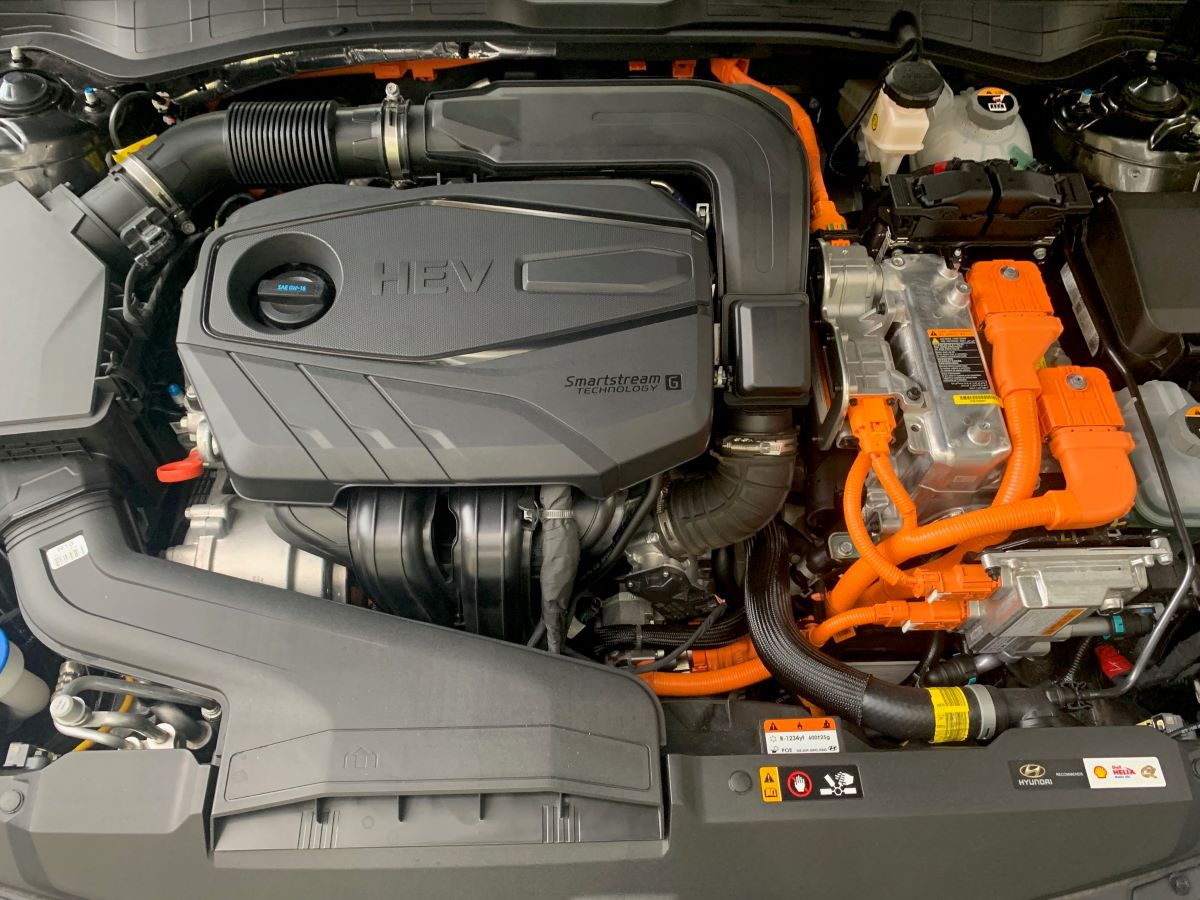The 2020 Sonata Hybrid sedan is all new and more efficient than ever.
Just months after releasing an all-new Sonata sedan, Hyundai follows with a gas-electric version, best known as the Sonata Hybrid. Visually, this adaptation is closely related to the standard model, but it is the hybrid drivetrain that sets this one apart.
Today’s hybrids remain the most fuel-efficient models on the market. That it comes as a spacious midsize family sedan is what makes the Sonata Hybrid remarkable.
2020 Hyundai Sonata Review
Hyundai offers the 2020 Sonata Hybrid in three trims: Blue ($27,750), SEL ($29,900), and Limited ($35,300). Add $975 for the destination charge. This front-wheel-drive sedan seats five. The standard gas-powered model is sold separately. We reviewed that model here.
Exterior
We reviewed the standard Sonata sedan in February. Much of what can be said about the conventional model carries over to the hybrid. But there are a few subtle differences, including a cross-hole grille design with active shutters, aerodynamic wheels, and a unique spoiler.
All these tweaks combined create better airflow as the sedan moves down the road. Indeed, this sedan is slippery with a stellar 0.24 coefficient of drag.
There is another feature unique to the hybrid that’s easy to overlook. Well, if you don’t look at the roof, that is. That feature is a Solar Roof System, designed to capture the sun’s rays and convert it into electricity to supply the battery system.
Hyundai says that the system can extend driving range by a couple of miles after six hours of charging. In effect, it can add up to 700 miles of additional driving annually. It’s included on the Limited trim.
Hyundai equips the Sonata Hybrid with standard LED headlights, daytime running lights, and taillamps. On the top trim, you’ll find matrix and full LED lighting. All trims come with automatic light control including high beams, power-folding side mirrors, and aluminum-alloy wheels.
Various trim embellishments, rain-sensing wipers, and 17-inch wheels accompany the upper trims.
Interior
The Sonata Hybrid is one of the largest models in its class. In fact, by some measures, it is considered a large car. We won’t go that far, but we cannot understate just how roomy this sedan is.
The front passengers enjoy all the space you’d expect with ample head, shoulder, hip, and legroom. In the rear, three can sit comfortably, although legroom becomes tight if either front passenger pushes his/her seat back.
We’ve long appreciated Hyundai’s fit and finish as well as its material choices, especially with the top-trim Limited. It’s a standard fare look with the Blue and SEL trims, while any Limited level Hyundai adds more soft-touch materials and replaces the cloth seats with leather.
We weren’t fans of the push-button transmission system, at least not at first, but then we appreciated how it frees up space and gives the interior a clean, even sophisticated look. You’ll find ample storage areas throughout, which is something we expect in this class.
Hyundai did a stellar job by keeping the cabin quiet, which is nearly on par with some luxury models and definitely as quiet as a Buick. The trunk space measures 16 cubic feet and that’s in line with other midsize models. A 60/40 split fold-down rear bench seat expands that storage area.
Besides full power accessories, every Sonata Hybrid has keyless entry with push-button start, a tilt-and-telescopic steering column, and dual-zone climate control. Among the trim upgrades are power front seats, heated front seats, ventilated front seats, a heated steering wheel, a head-up display, and an imitation leather-wrapped dashboard.
Safety
Beyond the requisite rearview monitor, every Sonata Hybrid comes with blind-spot collision-avoidance assist with rear cross-traffic alert, forward collision-avoidance alert with pedestrian detection, adaptive cruise control, and rear occupant alert.
To enjoy the full suite of driver-assist features, upgrading to the Limited does it. Here, Hyundai supplies a blind-spot view monitor, parking collision-avoidance assist rear, an around-view monitor, and front and rear parking sensors. There’s no self-driving feature available, but that’s something Hyundai can add to new models in the next few years.
Technology
Hyundai goes big on tech items, beginning with an 8-inch touch-screen display. This package includes a six-speaker audio system, Bluetooth, HD Radio, satellite radio, and Apple CarPlay and Android Auto smartphone integration. A USB port, iPod jacks and a 12-volt outlet are included.
Move up to the SEL trim and Hyundai includes a 12-speaker Bose audio system. You’ll also find one additional USB port for the rear seating area and a wireless charging pad. We love wireless charging, especially the convenience of no wires. Move up to the Limited trim and you’ll find a 10.25-inch display.
Performance
Hybrid models are designed for efficiency, but there is a power component on hand as well. That some manufacturers can strike a balance between the two is something we’re clearly seeing after more than 20 years of proving this technology.
All Sonata Hybrid models come with a 2.0-liter four-cylinder engine, a six-speed automatic transmission, and an electric motor. Under normal acceleration, the Sonata Hybrid supplies average power, but at full throttle the entire powertrain system kicks in, delivering a noteworthy 192 horsepower. That’s 1 hp better than the standard model powered by a 2.5-liter gas engine.
Yet, the Sonata Hybrid is anything but brisk. It moves away from a hard stop steadily and only supplies full power when pressed into action. By no means does it supply driving excitement: the steering is average, but the sedan does stay centered while navigating twisty roads.
Choose “eco” mode and the driving is sedate, but the benefit is clear: excellent fuel economy is within reach, bettering any modern gas-powered outfitted with the tiniest engine. Indeed, we averaged 45.3 mpg while driving well over 400 miles for the week. Our trips included a rich mix of local and highway driving or the way you would experience real-world driving.
Competitive Set
The hybrid market is still dominated by the Toyota Prius, but there are other models to consider.
This Hyundai’s nearest competitors are the Toyota Camry Hybrid and the Honda Accord Hybrid. It’s company stablemate, Kia, also fields an Optima Hybrid sedan. A new version of that model is scheduled to arrive in 2021.
Our Recommendation
Go “Blue” if you want to maximize fuel economy at the expense of additional creature comforts. Even in “basic” form, the Sonata Hybrid has a nice collection of amenities.
But if you’re looking at long-term ownership, the Limited edition is hard to pass. It supplies the best example of a premium Hyundai model, while still costing less than some fully equipped gas-only competitors.
2020 Hyundai Sonata Hybrid Specifications
| Hyundai | 2020 Sonata Hybrid |
|---|---|
| Segment | Midsize Sedan |
| Price Range | $27,750 to $35,300 |
| Destination Charge | $995 |
| Standard Engine | 2.0-liter, I4 |
| Horsepower | 150 @ 6,000 rpm (192 combined) |
| Torque (lb.-ft.) | 139 @ 5,000 rpm |
| Transmission | 6-speed automatic |
| Electric Motor | 1.6-liter, turbo I4 |
| Horsepower | 51 @ 1,800 to 2,300 rpm |
| Torque (lb.-ft.) | 151 lb.ft. @ 0-1,800 rpm |
| Battery Type | Lithium-Ion Polymer |
| Seating | 5 |
| Curb Weight (pounds) | 3,325 to 3,530 |
| Wheelbase (inches) | 111.8 |
| Length (inches) | 192.9 |
| Width (inches) | 73.2 |
| Height (inches) | 56.9 |
| Headroom (f,r…inches) | 40.0, 37.8. |
| Legroom (f,r…inches) | 46.1, 34.8 |
| Shoulder room (f,r…inches) | 57.9, 56.1 |
| Hip room (f,r…inches) | 54.6, 54.4 |
| Storage (cubic feet) | 16.0 |
| Gross vehicle weight (pounds) | 4,519 |
| Towing (pounds) | NR |
| Payload (pounds) | NR |
| Fuel | Regular |
| Fuel Tank (gallons) | 13.2 |
| EPA Fuel MPG (city/highway/combined) | 45/51/47; 50/54/52 (Blue) |
| Manufacturing Plant | Montgomery, Alabama |
Data compiled by Tom Keegan. Specifications supplied by the manufacturer.
See Also – Spotlights on the 2020 Hyundai Kona
Photos copyright Auto Trends Magazine. All rights reserved.
- 2024 Mazda CX-50: A Compact SUV with Premium Aspirations - Apr 15, 2024
- 2024 Ford Mustang (Iconic Pony Car Evolves) - Apr 4, 2024
- 2024 Ford Maverick (Looks Like a Truck, Drives Like a Car) - Mar 28, 2024

